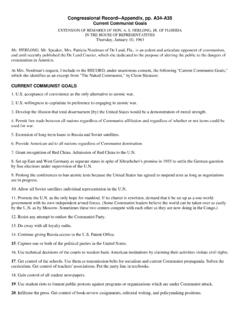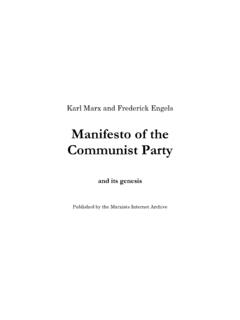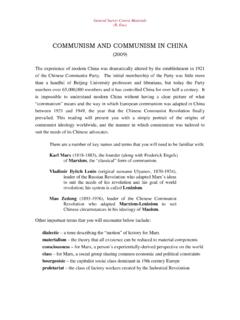Transcription of Manifesto of the Communist Party
1 Manifesto of the Communist Party by Karl Marx and Frederick Engels February 1848 Written: Late 1847; First Published: February 1848; Source: Marx/Engels Selected Works, Vol. One, Progress Publishers, Moscow, 1969, pp. 98-137; Translated: Samuel Moore in cooperation with Frederick Engels, 1888; Transcribed: by Zodiac and Brian Baggins; Proofed: and corrected against 1888 English Edition by Andy Blunden 2004; Copyleft: Marxists Internet Archive ( ) 1987, 2000, 2010. Permission is granted to distribute this document under the terms of the Creative Commons Attribution-Share-Alike License. Table of Contents Editorial Introduction .. 2 Preface to The 1872 German Edition ..4 Preface to The 1882 Russian Edition .. 5 Preface to The 1883 German Edition ..6 Preface to The 1888 English 7 Preface to The 1890 German Edition .. 10 Preface to The 1892 Polish Edition .. 12 Preface to The 1893 Italian 13 Manifesto of the Communist I. Bourgeois and Proletarians .. 14 II. Proletarians and Communists.
2 22 III. Socialist and Communist Literature ..28 1. Reactionary Socialism ..28 A. Feudal Socialism .. 28 B. Petty-Bourgeois Socialism .. 29 C. German or True Socialism .. 29 2. Conservative or Bourgeois Socialism .. 31 3. Critical-Utopian Socialism and 32 IV. Position of the Communists in Relation to the Various Existing Opposition Parties .. 34 Letter from Engels to Marx, 24 November 1847 .. 35 Draft of a Communist Confession of Faith .. 36 The Principles of Communism .. 41 Demands of the Communist Party in 55 The Paris Commune. Address to the International Workingmen s Association, May 58 Endnotes .. 67 2 Introduction Editorial Introduction The Manifesto of the Communist Party was written by Marx and Engels as the Communist League s programme on the instruction of its Second Congress (London, November 29-December 8, 1847), which signified a victory for the followers of a new proletarian line during the discussion of the programme questions. When Congress was still in preparation, Marx and Engels arrived at the conclusion that the final programme document should be in the form of a Party Manifesto (see Engels letter to Marx of November 23-24, 1847).
3 The catechism form usual for the secret societies of the time and retained in the Draft of a Communist Confession of Faith and Principles of Communism, was not suitable for a full and substantial exposition of the new revolutionary world outlook, for a comprehensive formulation of the proletarian movement s aims and tasks. See also Demands of the Communist Party in Germany, issued by Marx soon after publication of the Manifesto , which addressed the immediate demands of the movement. Marx and Engels began working together on the Manifesto while they were still in London immediately after the congress, and continued until about December 13 when Marx returned to Brussels; they resumed their work four days later (December 17) when Engels arrived there. After Engels departure for Paris at the end of December and up to his return on January 31, Marx worked on the Manifesto alone. Hurried by the Central Authority of the Communist League which provided him with certain documents ( , addresses of the People s Chamber (Halle) of the League of the Just of November 1846 and February 1847, and, apparently, documents of the First Congress of the Communist League pertaining to the discussion of the Party programme), Marx worked intensively on the Manifesto through almost the whole of January 1848.
4 At the end of January the manuscript was sent on to London to be printed in the German Workers Educational Society s print shop owned by a German emigrant J. E. Burghard, a member of the Communist League. The manuscript of the Manifesto has not survived. The only extant materials written in Marx s hand are a draft plan for Section III, showing his efforts to improve the structure of the Manifesto , and a page of a rough copy. The Manifesto came off the press at the end of February 1848. On February 29, the Educational Society decided to cover all the printing expenses. The first edition of the Manifesto was a 23-page pamphlet in a dark green cover. In April-May 1848 another edition was put out. The text took up 30 pages, some misprints of the first edition were corrected, and the punctuation improved. Subsequently this text was used by Marx and Engels as a basis for later authorised editions. Between March and July 1848 the Manifesto was printed in the Deutsche Londoner Zeitung, a democratic newspaper of the German emigrants.
5 Already that same year numerous efforts were made to publish the Manifesto in other European languages. A Danish, a Polish (in Paris) and a Swedish (under a different title: The Voice of Communism. Declaration of the Communist Party ) editions appeared in 1848. The translations into French, Italian and Spanish made at that time remained unpublished. In April 1848, Engels, then in Barmen, was translating the Manifesto into English, but he managed to translate only half of it, and the first English translation, made by Helen Macfarlane, was not published until two years later, between June and November 1850, in the Chartist journal The Red Republican. Its editor, Julian Harney, named the authors for the first time in the introduction to this publication. All earlier and many subsequent editions of the Manifesto were anonymous. The growing emancipation struggle of the proletariat in the 60s and 70s of the 19th century led to new editions of the Manifesto . The year 1872 saw a new German edition with minor corrections and a preface by Marx and Engels where they drew some conclusions from the experience of the Paris 3 Introduction Commune of 1871.
6 This and subsequent German editions (1883 and 1890) were entitled the Communist Manifesto . In 1872 the Manifesto was first published in America in Woodhull & Claflin s Weekly. The first Russian edition of the Manifesto , translated by Mikhail Bakunin with some distortions, appeared in Geneva in 1869. The faults of this edition were removed in the 1882 edition (translation by Georgi Plekhanov), for which Marx and Engels, who attributed great significance to the dissemination of Marxism in Russia, had written a special preface. After Marx s death, the Manifesto ran into several editions. Engels read through them all, wrote prefaces for the 1883 German edition and for the 1888 English edition in Samuel Moore s translation, which he also edited and supplied with notes. This edition served as a basis for many subsequent editions of the Manifesto in English in Britain, the United States and the USSR. In 1890, Engels prepared a further German edition, wrote a new preface to it, and added a number of notes.
7 In 1885, the newspaper Le Socialiste published the French translation of the Manifesto made by Marx s daughter Laura Lafargue and read by Engels. He also wrote prefaces to the 1892 Polish and 1893 Italian editions. This edition includes the two earlier versions of the Manifesto , namely the draft Communist Confession of Faith and The Principles of Communism, both authored by Engels, as well as the letter from Engels to Marx which poses the idea of publishing a Manifesto , rather than a catechism. The Manifesto addressed itself to a mass movement with historical significance, not a political sect. On the other hand, the Demands of the Communist Party in Germany is included to place the publication of the Manifesto in the context of the mass movement in Germany at the time, whose immediate demands are reflected by Marx in this pamphlet. Clearly the aims of the Manifesto were more far-reaching the movement in Germany at the time, and unlike the Demands, was intended to outlive the immediate conditions.
8 The Third Address to the International Workingmen s Association is included because in this speech Marx examines the movement of the working class manifested in the Paris Commune, and his observations here mark the only revisions to his social and historical vision made during his lifetime as a result of the development of the working class movement itself, clarifying some points and making others more concrete. Preface to The 1872 German Edition The Communist League, an international association of workers, which could of course be only a secret one, under conditions obtaining at the time, commissioned us, the undersigned, at the Congress held in London in November 1847, to write for publication a detailed theoretical and practical programme for the Party . Such was the origin of the following Manifesto , the manuscript of which travelled to London to be printed a few weeks before the February [French] Revolution [in 1848].
9 First published in German, it has been republished in that language in at least twelve different editions in Germany, England, and America. It was published in English for the first time in 1850 in the Red Republican, London, translated by Miss Helen Macfarlane, and in 1871 in at least three different translations in America. The French version first appeared in Paris shortly before the June insurrection of 1848, and recently in Le Socialiste of New York. A new translation is in the course of preparation. A Polish version appeared in London shortly after it was first published in Germany. A Russian translation was published in Geneva in the sixties1. Into Danish, too, it was translated shortly after its appearance. However much that state of things may have altered during the last twenty-five years, the general principles laid down in the Manifesto are, on the whole, as correct today as ever. Here and there, some detail might be improved.
10 The practical application of the principles will depend, as the Manifesto itself states, everywhere and at all times, on the historical conditions for the time being existing, and, for that reason, no special stress is laid on the revolutionary measures proposed at the end of Section II. That passage would, in many respects, be very differently worded today. In view of the gigantic strides of Modern Industry since 1848, and of the accompanying improved and extended organization of the working class, in view of the practical experience gained, first in the February Revolution, and then, still more, in the Paris Commune, where the proletariat for the first time held political power for two whole months, this programme has in some details been antiquated. One thing especially was proved by the Commune, viz., that the working class cannot simply lay hold of the ready-made state machinery, and wield it for its own purposes.







